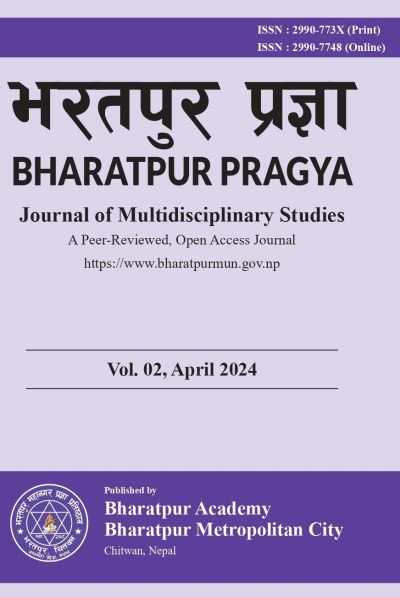Climate Change-induced Livelihood Insecurity in Narayani-Gandak Basin of Nepal
DOI:
https://doi.org/10.3126/bpjms.v2i01.65869Keywords:
Narayani basin, climate change, flood, livelihoodAbstract
Nepal is one of the most disaster-prone countries in the world. Nepal is highly vulnerable to climate risks and disasters. It ranks 4th, 11th, and 13th in terms of vulnerability to climate change, earthquake, and flood risks, respectively. Due to intensive, concentrated, and erratic precipitation, climate change-induced disasters such as 'too much water and too little water' are rapidly increasing in Nepal and the ‘too much water’ has been affecting riverine communities, significantly, in the Terai region of Nepal. The communities of the Narayani basin have been forced to encounter floods every year due to the perennial Narayani and Rapti including other local seasonal rivers. While these rivers seem to b e providing services for irrigation to nurture agricultural products, to some extent, the riparian communities have also been forced to encounter extensive amounts of losses and damages to lives, livestock, crops, and property, which have resulted in losses of livelihoods, and generated serious concerns for communities due to surmounting risks of flood like natural hazards turning into disasters. Employing a mixed-method research approach, we investigated how climate change-induced hazards such as floods turning into disasters have affected the livelihoods of people living in the riverine communities of Chitwan. The two research objectives we explored were i) to examine the impacts of climate change and floods on agriculture and the livelihoods of community people, and ii) to investigate the adaptive methods adopted by local communities to combat climate change-induced flooding for building climate/flood resilient communities. The findings of the research demonstrated that climatic changes have interacted with socio-economic and agricultural practices and significantly affecting livelihood of the communities in Chitwan. In response to changing climatic conditions and unanticipated weather patterns, people in the communities are gradually adjusting their agricultural practices, covering the losses and damages through insurance policies and diversifying the income generating sources.
Downloads
Downloads
Published
How to Cite
Issue
Section
License

This work is licensed under a Creative Commons Attribution-NonCommercial 4.0 International License.
CC BY-NC This license allows reusers to distribute, remix, adapt, and build upon the material in any medium or format for noncommercial purposes only, and only so long as attribution is given to the creator.




